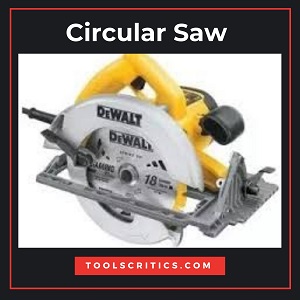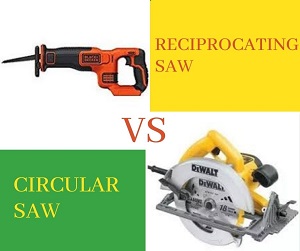Suppose you have fairly new to woodworking power tools, you may have noticed that a reciprocating saw and a circular saw are the most used power tools in the field. So, how do these two power tools compare?
You are about to find that out in this reciprocating saw Vs circular saw review. Let’s get on with it.
Table of Contents
Circular Saw

This is a power tool, which cuts material with a round blade that comes with sharp metal teeth on the edges. The saw can be mounted on the tale or it can be handheld. It is mostly used by cabinet makers and carpenters to make multiple cuts.
The circular saw is the best pick for making clean and accurate cuts. Also, the shape metal teeth are coated with diamonds or carbide.
You can use a circular saw to cut through timber, metal sheets, or dense granite. Plus, it can help you make plunge cuts, rip cuts, and cross-cuts with minimal fuss.
Good Sides
- Offer clean and precise cuts
- Can be used to make angular cuts with ease
- Highly versatile; it can make angular, rip-cuts, cross-cuts, and straight cuts.
Could Be Better
- Tends to overhead too often
- Relatively heavyweight and difficult to handle
- Can only work efficiently on a flat surface
Applications of a Circular Saw
- Best tool for construction projects; it can cut through metal, granite, and plexiglass
- Can get clean and accurate cuts on different materials
- Used to make straight and angular cuts in heavy dense materials
Reciprocating Saw

This is a handheld power tool that is mostly used for remodeling and demolition applications. The saw employs a push & pull motion to cut through materials. With this saw, it comes with a knife-like blade that has jagged teeth attached to the system.
A reciprocating saw allows you to cut through metal, plastic, nails, or wood. To operate it, you would need both your hands for better stability and control.
Unfortunately, this saw cannot make angled cuts, and it also generates a lot of vibrations as you work with it. As a result, it may not be the best pick for making clean and accurate cuts. It will leave rough edge cuts, but it can cut through any material.
Good Sides
- Highly portable
- Allows you to make speed adjustment for different materials
- Can be used to make both horizontal and vertical cuts. This assures you of versatility.
Could Be Better
- They can’t make angular cuts
- Reciprocating saws don’t deliver clean and smooth cuts
- They don’t come with a blade guard.
Applications of a Reciprocating Saw
- They are used for making flush cuts
- They can be used for cutting hedges and branches (yard work)
- Best tool for demolishing and remodeling projects
Reciprocating Saw Vs Circular Saw: How Do They Compare?

Blade Type
One major difference between a circular saw and a reciprocating saw is the type of blade. The circular saw comes with a disc blade with large diamond or carbide-coated teeth. On the other hand, a reciprocating saw has a knife-like blade hooked up to the system.
Cutting Ability
With the different blades on these two power tools, it means that they will deliver different cutting abilities. A reciprocating saw can easily slice through any piece of wood with ease. However, it will leave a rough edge after you’re done. With the circular saw, it offers you a clean and precise cut, but its cutting pace is slower than the reciprocating saw.
Besides that, a reciprocating saw is mostly used in rough and dimensionless jobs, especially where fine and smooth finishing is not needed. Conversely, a circular saw is specifically used for making clean and precise cuts.
Shape/Size
The shape of these two saws is another factor that highlights their difference. A circular saw, for example is designed with a circular shape and it is mounted with a disc blade in the center. But a reciprocating saw looks just like a rifle. The holding grip is equally the same.
In terms of how they are operated, you will need both your hands to operate these two powerful tools. The difference comes in the placement of the hands.
Affordability
Another point that differentiates these power tools is the affordability or the price. Generally, both the reciprocating saw and circular saw are affordable. However, a circular saw comes slightly higher in terms of the price tag at around $90 to $240. On the other hand, a reciprocating saw will cost you between $40 and $160.
The reason a circular saw is more expensive than a reciprocating saw is the fact that it is more versatile and it delivers clean and accurate cuts.
Which of the Two Should You Choose?
Generally, both tools are suited for different applications. For example, if you have demolition and renovation projects, the ultimate tool should be a reciprocating saw. The reason for going with this tool is that it can quickly and efficiently cut through wood, metal, or plastic. You can also manipulate it effectively into narrow spaces, thanks to its design and shape.
Conversely, a circular saw is a versatile tool that would suit you with most of your carpentry projects. Plus, if the circular saw is mounted with the right blade, it can be super powerful and slice through ultra-tough materials.
By the way, circular saws kick a lot less than reciprocating saws. That’s why they are best suited for inexperienced users or DIYers.
FAQs
Q. Can you cut straight lines with a reciprocating saw?
Ans. Yes, a reciprocating saw can be used to cut the wood into a straight line. However, you will need the right blade and perfect technique to achieve this.
Q. How thick can a reciprocating saw cut?
Ans. If you’re using the heavy-duty blades on a reciprocating saw, you can cut up to 12 inches of timber in diameter. But preferably, the saw should be used to cut in the range of 6 to 8 inches of timber.
Q. Are the reciprocating saw and circular saw interchangeable?
Ans. No, these saws cannot be used interchangeably. They both are useful in a construction site or woodworking workshop, but their applications are different.
Final Words
One thing you should know is that the reciprocating saw is not designed to be used in the place of a circular saw. Therefore, you should use them in the right application at all times. Above all, make sure you observe the necessary safety precautions when using either of the saws.